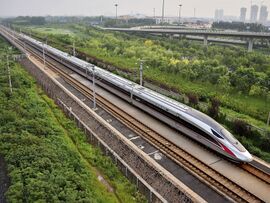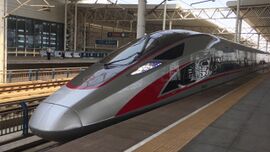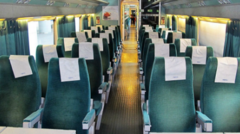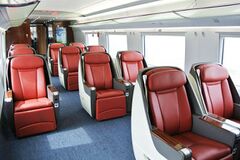Zhenia National Express
 | |
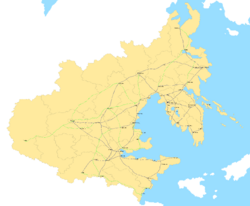 Map of the Zhenian National Express network. Blue tracks are dedicated, while light green are conventional. | |
| Dates of operation | 1974–Present |
|---|---|
| Track gauge | 1,435 mm (4 ft 8 1⁄2 in) Standard gauge |
| Electrification | 25 kV 60 Hz AC |
| Headquarters | Changan, Zhenia |
| Website | www.znx.zhen |
The Zhenia National Express (Zhenian: 진국고속철도), commonly stylized as ZNX, is Zhenia's intercity high-speed rail network operated by the Zhenia National Railway Company (ZhenRail). It was constructed to connect major population centers located in both mainland Zhenia and the Danguk Peninsula, as well as linking major cities and distant segments of the Golden Arc region to Daedo in order to revitalize passenger transport via rail. With a length of almost 20,000 kilometers as of 2019, including conventional tracks with HSR service, it is one of the most extensive high-speed rail networks in the world.
Construction of high-speed lines in Zhenia began in the mid-1960s, with the first lines, the Daedo-Changan line, commencing service in March 1, 1974. Further developments resulted in the completion of the Trans Golden Arc line in 1981, the Shinhang-Ariul line in 1987 and later other developments, ultimately resulting in 94% of Zhenians living within 100 kilometers from their nearest high-speed rail station. ZhenRail currently defines the term "high-speed railway" as any line capable of passenger services at or exceeding 250 km/h on its routes, a definition that was revised in 2000.
The maximum speed for trains in regular service is at 400 km/h, although signal and infrastructure systems allow for a theoretical maximum speed of 430 km/h. While initial trains operated at speeds around 240 km/h, later EMU trains brought up the average speed to around 350 km/h. Maglev trains fitted with linear motors, estimated to have a maximum speed of over 500 km/h, are currently under testing in the Daedo-Changan line as of 2019, with the first units expected to enter service in 2025.
History
Initial plans for a high-speed train in Zhenia emerged as early as the 1930s, when the existing passenger rail services, particularly those within the Danguk Peninsula and the Golden Arc was facing congestion and was expected to be unable to catch up ever-increasing demand. Express services stopping in fewer stations along the Gulf and the Peninsula were operated, while existing rail lines, particularly the Danguk Peninsula and the Gulf lines, were expanded and newer, faster locomotives were being used in priority passenger services. Parallel to improvements on existing infrastructure, a fundamentally new solution of building lines of electrically-powered trains, as opposed to using diesel locomotives, were devised as well. The Second Great War, however, halted the idea beyond initial development, and the idea was forgotten until its resurfacing during the economic resurgence of the Third Republic.
In 1958, seeing that numerous existing rails were operating well beyond design capacity due to increases in both passenger and cargo demand, the newly-established ZhenRail called for a completely newly-built, electrified railway supplementing existing passenger rail services. Although many proposals regarding this were made, the finalized proposal would include a network of completely new routes designed exclusively for such high-speed electric trains, with the hope that existing steam and locomotives will ultimately be superseded by speed. The proposal gained approval from Kim Shimin in 1959, the same year the routes were finalized and land acquisition began.
The first route built at the time was the Daedo-Changan route, the conventional rails of which had been congested with both industrial and passenger demand by then. Construction in the Daedo-Changan line became an exemplary case for all future construction of ZNX routes. While some were built directly on level surfaces on land, most of the initial segment was built on viaducts, bridges and tunnels. Although initially unplanned, the task to upgrade and electrify existing conventional railways were also added to the plan, as it was anticipated that the new high-speed rail might have to run on conventional tracks in the worst of circumstances. Most tracks in urban areas were built at least 20 meters below the surface, in order to minimize contact with existing rail services. While construction of the Daedo-Changan route, with numerous engineering challenges, were completed by 1971, it would undergo extensive testing for the next three years. During testing, the initial trains reached a maximum speed of 240 km/h, well above the initial objective of 210 km/h - in scheduled service, however, the initial trains will operate at a maximum speed of 220 km/h. First scheduled passenger service began on March 1, 1974 - a day still commemorated as National Rail Day in the nation.
Following the opening of the Daedo-Changan route, construction of more ZNX-dedicated high-speed tracks, as well as the electrification and upgrades of existing tracks across the nation, spurred; the Trans Golden Arc line, spanning the entirety of the Golden Arc region from southern Balhae Province to Namhae Province, inaugurated in 1981, while the Shinhang-Ariul route, opened in 1987, connected the traditionally neglected Western Zhenia to the Golden Arc area. Advancements in breaking and motor technology, as well as improvements in the signal and safety systems, also led to improvements in speed: by 2000, all ZNX trains were operating at a maximum speed of over 300 km/h with the introduction of the ECU-320, while the speed limit was once again raised to 400 km/h in 2014 with the advent of the EMU-400 trains into service. A further plan to build maglev lines between Daedo and Changan, as well as along the Golden Arc region, has been undergoing development since the 1980s, with initial service expected to begin in 2025.
Railway Network
Major Stations
Depots
Testing Facilities
Infrastructure
Rails
All ZNX trains run on dedicated 1,435-mm standard gauge rails, with the exception of using conventional standard-gauge rails in dense urban areas. At-grade road and pedestrian pathway crossings do not exist in all tracks served by the ZNX, adhering to the philosophy of minimizing outside interference on ZNX tracks; trespassing dedicated ZNX rails via means other than ZNX trains is strictly prohibited by law. Instead of going around obstacles like most older conventional tracks, ZNX tracks use tunnels and viaducts to go under, over and through them, with a minimum curve radius of 3,600 meters. The exits of ZNX tunnels are designed with the upper parts of the tunnel sticking out rather than the opposite, greatly reducing the boom.
ZNX tracks uses continuous welded rail and swingnose crossing points instead of conventional switches to minimize gaps in order to terminate gaps at turnouts and crossings, while also minimizing vibration when operating at high speeds. Tracks are slab-like and ballastless, adding to the durability of the tracks when ZNX trains operate in high speeds; slab tracks are firmly added into concrete bed sections, supported by concrete upstands for increased stability. They are then joined by expansion joints to evade gauge fluctuation and deformation thermal elongation and shrinkage.
Stations
Many ZNX stations across the nation are large, enclosed aboveground structures resembling those of many airport terminals today in terms of size and layout, consisting of glass-covered concourses supported by steel girders and concrete columns, creating a large main hall to function as both the departure and arrival halls of the station. ZNX tracks, in most cases, run parallel to the length of the concourse, mostly on the rear and often away from the main level of the concourse to minimize the interference the tracks cause on the concourse. Most transportation options, including a driveway loop for buses, taxis and other automobiles, are available in front of the station, while urban rail lines are usually linked to the station via underground lines. While an array of benches, ticketing areas and other facilities form up a lion share of the main concourse, recent attempts to incorporate private capital into ZNX stations have resulted in department stores, cinemas and other cultural facilities becoming a part of the station.
The main concourse and the tracks are separated by a gate, where all passenger tickets are clipped for admittance. The platforms themselves are normally either covered with a large glass canopy altogether (along with the tracks) as a part of the concourse or are covered with canopies of their own, although the former is generally the case with larger stations. Overpasses or underpasses, depending on the station, connect the platforms in case the passenger to move to another platform. Although the platforms feature fewer amenities than the concourse, newspaper stands and small convenience stores are present on many ZNX platforms.
Power and Signalling
All ZNX trains are powered by electricity, relying on high-voltage overhead lines suspended by catenaries supplying electricity at 25 kV 60 Hz AC, with each train receiving power from overhead lines via pantograph. The power from pantographs, in the case of electric multiple units, is distributed to each car almost evenly to reduce the load on the axles of power vehicles.
The Zhenia National Express employs the TVM cab-signalling system in tandem with a comprehensive system of automatic train protection (ATP), which also includes an automatic train stop system as an emergency safety measure. A centralized traffic control system manages the nationwide network, overseeing all tasks related to train movement, tracks, station and schedule. The entire system has been computerized by the early 1990s, while GPS augmentation into the control system being introduced by 1995. In 2019, a new system employing LTE broadband communication technology has been introduced in the Trans Golden Arc line, allowing for more accurate real-time tracking and control at the end of the central system.
Traffic
Operation
Classes of Service
Classes by Seating
The lowest but often the most common class available on the ZNX is the Standard Class. Primarily aimed for those with tight budgets, Standard Class seats normally arranged in a 2 + 2 seating configuration per row, while each passenger car has 18 rows. Each seat until the EMU-400 has a seat pitch of 960 mm (seats on the EMU-400 have a pitch of 980 mm), all of which are cushioned, adjustable recliner seats. Other amenities include cup holders, overhead storage, foot rests, electrical outlets via USB ports, onboard Wi-Fi since 2007 and AVOD screens on every seat in newer trains. There has, however, been talks on densifying the Standard Class seats into a 3 + 2 configuration rather than the current 2 + 2 configuration.
The Executive Class is a higher class found on ZNX trains, primarily aimed for businessmen and less budget-constrained tourists seeking higher quality than the Standard Class. With its seating arranged in a 2 + 1 configuration per row, all of which are separated by the 'Cell' partitions since 1999 to allow for greater privacy. Normally with 10 or 12 rows in each passenger car, seats in the Executive Class are lined with leather and are reclinable further than the Standard Class, with some newer trains being fully reclinable to 180 degrees. Other amenities in the Executive Class include a personal reading light, electrical outlets, provided headphones, complimentary snacks on shorter routes, AVOD screens and all other amenities on the Standard Class.
The highest possible seating class available on ZNX trains are the Sleeper Class, which operate on routes taking at least 10 hours at the speeds possible at given tracks. The necessity of the Sleeper Class on ZNX trains surfaced with the opening of the Trans Golden Arc line in 1981, when the estimated journey was expected to take almost 24 hours to complete, as well as the need to compete with airlines serving similar routes. The Sleeper Class exists in three variants - a personal compartment, a duplex compartment, and a 'quad-pod' compartment, each corresponding to the number of beds in a single given compartment. Although monetarily the most expensive seating class on ZNX trains, amenities of the Sleeper Class are objectively better than those of the other two classes.
Classes by Scheduling
Classes can also be classified according to scheduling, specifically depending on how many stops the train makes and the time the trains depart. Rapid trains (Zhenian: 특급열차), stopping only at major and designated stations, tend to complete the journey faster than their local counterparts, although they are around 10% more expensive than their Regular counterparts. Although the name should not be confused with non-ZNX trains, local trains (Zhenian: 각역정열차) stop at every ZNX-designated station and may often run on conventional tracks rather than dedicated high-speed tracks, resulting in 5-10% lower fares than their regular counterparts. Regular Trains (Zhenian: 일반열차) are the middle line between rapid and local trains, stopping at all major stations and some selected stations that vary by train and time - they are the standard for most pricing examples of the ZNX. Nighttime trains (Zhenian: 야간열차), are priced at around 20% lower prices than their daytime counterparts, although there is no such difference in Sleeper Class seats.
Fares and Ticketing
In principle, all seats in the Zhenia National Express are priced proportionately by distance. As of January 2020, for a Standard Class seat, each kilometer costs a traveler around $0.25 on high speed tracks ($0.23 for every kilometer on a conventional track), with an additional ticketing charge equal to $3.40, a seating charge equivalent to around $5.00 (which is ignored if the traveler chooses the free seat option) and miscellaneous costs that add up to around $0.80 at the end of the traveler; in theory, the shortest possible ride on the Zhenia National Express on a kilometer-long conventional track would cost a minimum of $4.43 for the customer. Seats on the Executive Class increases the price per kilometer by 40% and the seating charge by 50%, while seats on the Sleeper Class on long-haul routes start from an additional equivalent of $100 for every 1,200 kilometers, have a seating charge equivalent to around $12.00 and cost $0.46 per kilometer on the customer. The total price excluding the ticketing charge would increase by 10% if the traveler chooses a 'rapid' level train, minimizing unnecessary stops in-between.
Both on-site and online ticket sales networks are available for purchasing the tickets on the Zhenia National Express; both processes are essentially the same, mostly differing in the medium through which the ticketing is done. At the end of the customer, the customer requests a certain quantity of tickets for a certain route and class, either one way or return; with input from the clerk (on-site ticketing) or through the online service (online ticketing), the system returns with the set of available tickets fitting the criteria, allowing for the customer to choose among them. After the ticket is generated through this process and the subsequent monetary transaction is made, the sale is completed. Combined tickets between ZNX and non-ZNX services are also available through a similar process, as the Zhenia National Railway Company operates both ZNX and non-ZNX services; however, it is directly compatible with most intra-urban public transport means such as subways. Tickets can be reserved up to 90 days in advanced and be cancelled without a cancellation fee until 24 hours before the train's departure. Cancellation is available through various means, although it does not have to be the same way the ticketing was originally done. A cancellation fee of 20% of the original ticket fee applies for cancellations between 24 hours and 6 hours prior to departure; the percentage rises to 40%, 56% and finally 100% (meaning that sales are final by such point) between 6 hours and 90 minutes, 90 minutes and 15 minutes prior to departure, and finally after the train's departure respectively.
Ridership
Ownership and Maintenance
Rolling Stock
Passenger Trains
- EMU-350: The first electric multiple unit trains introduced in ZNX service, with a maximum speed of around 350 km/h.
- EMU-400: The most-recently introduced type of trains in ZNX lines. Essentially an improvement of the EMU-350, it has improved in maximum and operational speed, acceleration and deceleration rate and tilting capability.
Experimental Trains
Maintenance Trains
Train Types
Exports
In August 2018, the Zhenia National Railway Company announced the sales of a total of 322 EMU-400 vehicles and associated training services to the Great Northern Lines, which primarily services the nations of Educandi and Grothbord. The first EMU-400 trains are set to be delivered in Educandi in February 2020 and would operate through intercity routes between major cities of the nations, including the high-demand route between Edurre and Volkstadt.
Future Development
Extension into the Haedong Islands
Western Line Extension Plan
The Seobu High-Speed Line plan is set to form the new core of the extension of ZNX services into a dedicated high-speed line between Ariul and Jangsan, as well as smaller western cities in-between.
Maglev Line plan
See Also
- Zhenia National Railway Company, the primary operator of the ZNX.
